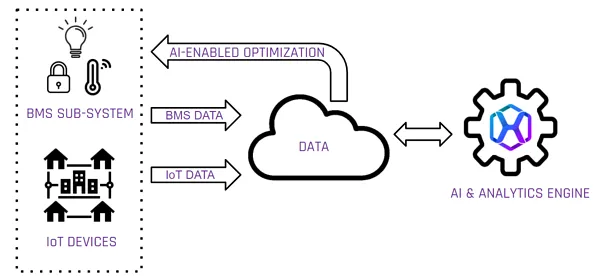
Facilities use energy, often lots of it and not in an efficient way. Energy is a major factor in the cost of doing business. Facility optimization, in simple terms, means the ability to improve equipment, building and operational performance by optimizing resource use.
An effective facility optimization program assesses and fixes the root cause of immediate problems and also addresses energy waste. The benefits are immediate, setting facility management up for more predictable operational cost management.
Leveraging Artificial intelligence (AI) to optimize facility management has the power to not only automate buildings, but to make them truly adaptive, smart and agile. Increasingly, facilities are outfitted with sensors and IoT technologies, that enable systems to communicate with each other within a building management system (BMS) platform.
BMS platforms can run building systems on conclusions drawn through the use of artificial intelligence and machine learning. The AI & Analytics Engine, is ably to flexibly integrate with BMS technologies and the BMS platform to automatically adjust various subsystem settings with minimal human involvement to improve facility management processes, operations and outcomes through;
- Enhanced facility management decision making & reduced human error;
- Replacing preventative and reactive maintenance with predictive maintenance models;
- Detection and prevention of faults via anomaly detection;
- Improved occupancy experiences through automated, controlled, and use-adaptive environments;
- Improved safety and security planning and controls; and
- Lower total operational cost and greater energy efficiency.
For other relevant use cases, check out our article on the Top 18 essential AI Use Cases in Leading Industries!
Facility Management Challenges
Modern buildings are becoming more multi-functional and crowded, with a higher level of interplay between the different systems involved, making facility management more complex. Increasingly facility managers are adopting ‘smart’ building technologies to create better experiences for occupiers, reduce the operational and energy costs of facilities and optimize the management and maintenance of facilities.
Buildings are often outfitted with BMS sensors and IoT technologies. At its core, IoT and sensors do not provide intelligence, however, they enable systems to communicate with each other within a building management system (BMS) platform. AI can overlay intelligence to BMS systems, providing predictive insight and automation, making facilities more interactive and responsive to their occupants and their needs, and enabling greater operational and energy efficiencies.
“Buildings currently account for around 40% of global energy use, with AI technologies offering opportunity to reduce energy consumption through better automation, control, and reliability and improve the safety comfort and experience of building occupants.”
– Rav Panchalingam & Ka C. Chan (2019) A state-of-the-art review on artificial intelligence for Smart Buildings, Intelligent Buildings International
The AI Solution
In a broader context, The AI & Analytics Engine can be applied across a variety of areas within facility management. In particular, building management platforms through:
- Forecasting: Where the Engine can be used to study and analyse historical data and make accurate predictions about operational needs.
- Anomaly Detection: Fault detection and diagnostic operations to determine if there are issues with the equipment. With the Engine you can preemptively report any anomaly which may occur. With AI/ML, system issues can be detected and tracked.
- Equipment Groups & Systems: Buildings have many different HVAC systems running concurrently. The Engine can be used as an aggregator in establishing better coordination between the various disparate systems. It can monitor and track how different systems interact and learn from the data, and adjust the existing BMS that interfaces with control systems for lighting, heating, and air conditioning (HVAC) within the facility.
-
-
The AI & Analytics Engine can be deployed on the cloud or managed on-premises and connect to existing cloud or data storage infrastructure.
Simplicity with The AI & Analytics Engine
The AI & Analytics Engine provides a simple to implement intelligence overlay to existing BMS. The cloud can aggregate the IoT data and BMS data into Big Data. The AI & Analytics Engine would then process the Big Data, to produce automated intelligent controls or insights. AI optimizations would then be fed back to the legacy BMS to control HVAC programming or to display insights within the BMS interface.
The architecture below implements a type of virtual BMS that treats the on-site BMS as a sub-system. Any higher-order intelligence implemented in the cloud would override the on-site BMS. This overlay of intelligence on top of the BMS will generate cost savings and occupancy experience enhancements, through the optimized control of the sub-systems.

Benefits Across Industry
Maximizing the efficiency of facilities is a constant and challenging concern for management across a broad range of industry. The AI & Analytics Engine can be applied to AI-enable BMS systems and facility management processes to ultimately;
- Aid in gathering data insights on day-to-day site elements such as the signing in or signing out of staff, floor occupancies, traffic, and logistical operations.
- Improve temperature, lighting and humidity control providing more comfortable conditions to occupiers or improving the safety of facilities.
- Manage and automate energy usage to meet actual facility needs to reduce wasted resources.
- Help with climate control in facilities that manufacture highly sensitive IT equipment components or medical components
- Integrate with with fire safety, access control, and video surveillance, control of various building processes, preventing incidents that disrupt production
The AI & Analytics Engine provides a fast and configurable solution, flexibly integrated with existing BMS infrastructure to assist businesses to gain a competitive edge through optimizing their facility management.







